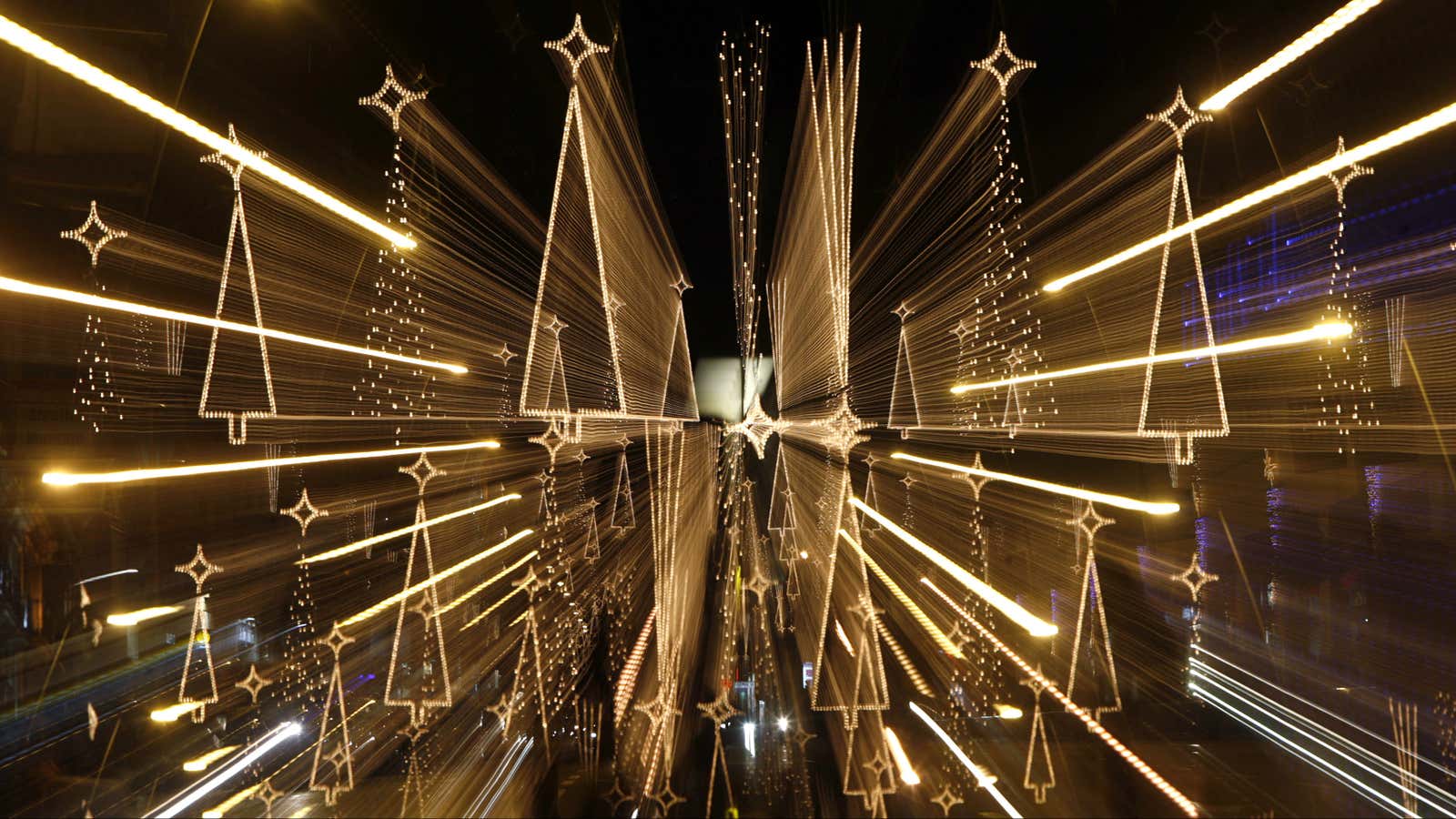Americans love to celebrate Christmas by covering every square inch of their homes—inside and out—with festive lighting. But cautionary tales have shown us just how much of a hassle that can be. In 2016, must we risk life and limb to set up a few strands of holiday lights? No, thanks to technological advances in recent years.
Here are some recent innovations in holiday lighting which should make decorating for Christmas a little less stressful.
Christmas lights that are actually easy to hang
Putting up Christmas lights is one of the most annoying yearly traditions. Invariably, they wind up bundled in a ball, in a box until you find them and realize you’ll spend the next few hours untangling a thicket of lights, only to spend more hours carefully placing them on a tree until you repeat the process all over again. Now there appears to be a simpler solution: A set of lights with a wonderfully stereotypical infomercial, called the Tree Dazzler, that can be draped over the top of a tree in one fell swoop. The lights are connected in vertical strands to a ring that sits at the top of the tree. It’s like a giant electrical shirt for the tree. Early reviews have been generally positive, and according to one Amazon customer, the light strands untangle easily. Just make sure to carefully pull the lights off after Christmas, and decorating next year’s tree should be just as pain-free. The $40 Tree Dazzler also comes with a remote that lets you set the lights to shimmer, or run through a litany of pre-programmed light shows.
Remote-control lights you can stick anywhere
Almost as infuriating as untangling and hanging lights on Christmas trees is untangling and hanging lights around the inside and outside of the house. Perhaps it’s time to give up traditional Christmas lights in favor of a new type of lighting called tape light, which looks pretty much like it sounds. Tape lights don’t need to be screwed or nailed into place—they just need to be unravelled and stuck to a surface with an adhesive on the underside of the tape. One band of tape light, Armacost Lighting, sells a 16-foot-long strip of LED lights for $125 that can be taped to just about any indoor or outdoor surface, and can emit red, blue, and green lights. You can also cut the strips down to whatever size you want using a pair of scissors. For an additional $110, you can add on a remote control to the mix, that’ll allow to control the colors of the lights, how quickly they rotate through colors, and their brightness. And given the fact that these strips aren’t particularly large or easy to spot when they’re not turned on, you could potentially leave them up all year round, saving even more setup hassle for future Christmases.
Lasers always make things better
If you don’t want to bother with hanging lights at all, the same company behind the draping lights released the Star Shower laser projector in time for the holidays last year. The laser projectors were apparently so popular last year that people were stealing the machines off of their neighbors’ lawns because they couldn’t buy their own, CNN reported. The projectors emit a laser light that’s diffracted into thousands of tiny star shapes that can be set to red, green, or a mixture of the two colors. The Star Shower can cover a wide area, meaning one $50 machine can cover the front of most houses in colored light—as long as your lawn is large enough for the projector to sit at least 10 ft. back (if not farther) from the house. Just make sure you don’t point one of the projectors at the sky, as the lasers could be disruptive for pilots.
Ask Alexa

If your lights are set, but you don’t want to bother with turning them on and off to save on energy costs, get a voice assistant to help you out. Smart-home hubs like Amazon’s Echo and the Google Home can both tie into internet-connected outlets, like Samsung SmartThings’ outlet, or the WeMo smart switch. You can then set up commands to control anything you plug into those outlets. So if you have a set of lights on the Christmas tree, you could ask Alexa to “turn on the Christmas tree,” without having to get up from the couch. One Reddit commenter suggests stringing together a few more smart outlets (including some that are weatherproof), so that you can just tell your virtual assistant to “turn on the Christmas lights” and have the entire house light up at once. Each smart plug will set you back between $30-$50, though, so maybe don’t go too crazy turning every outlet in your house into a smart outlet.
Internet of Christmas things
If just having a smart plug isn’t enough for you, perhaps an entire set of Bluetooth lights controlled by a smartphone app will do the trick. Lumenplay lights look just like regular Christmas lights, but are controlled by an app that lets owners change the lights to any color they desire. The app also lets you design light shows, and even set up shows to match songs if you set up some speakers to go along with your light show. This level of automation comes at a pretty steep cost: Each set of 12 lights costs between $50-$70, so covering an entire house, or even a living room, in internet-connected lights might prove to be more expensive than the gifts under the Christmas tree.
There are other options, if you’re more technically inclined. You can buy a microprocessor, LED lights, and cables to build a home-made light show system or build a light-up Christmas tree using a Raspberry Pi computer for less than what a house full of Lumenplay lights would cost. But you’re going to need to know how to solder very well, and have a lot of spare time on your hands between now and the holidays.
Extreme light shows
There are even more extreme versions of the computer-controlled light show. You know that one person in your neighborhood who puts way too much effort into his holiday lights, or maybe you’ve seen some on YouTube or a morning news show. Matt Johnson and his family in San Antonio, Texas took things a little further. They used a Raspberry Pi, along with a digital ethernet network controller, tape lights, lots of PVC plastic piping, and many, many, lights to build out a completely custom Christmas light show for their house that millions of people watch online every year. Johnson even sets up a radio transmitter to broadcast the music from his light show into cars that drive by.
Johnson, a longtime technologist and software developer, has made detailed videos explaining how to recreate every aspect of the light show, in case you have the patience and desire to build something like this to annoy your neighbors with as well.
It’s not easy to do, nor is it cheap, but pulling off a light show like this could also land you a viral YouTube video, and perhaps a few noise complaints from your neighbors.




